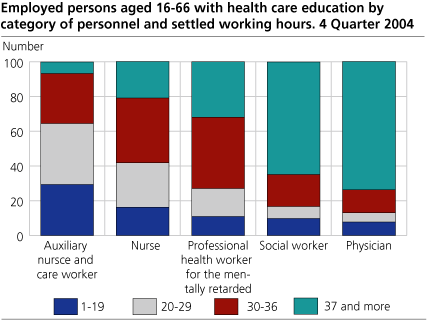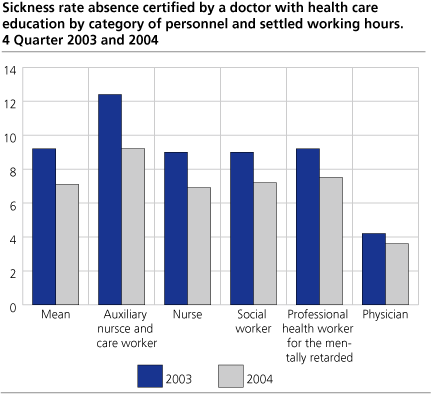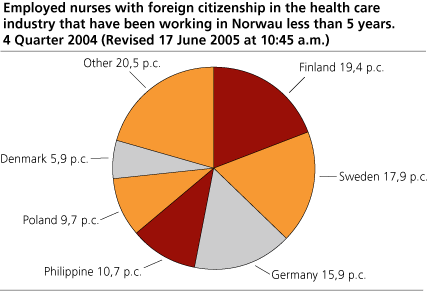Content
Published:
This is an archived release.
Increased employment with full time work
The number of employed people with health care education increased by 8 000 people from 2003 to 2004. The number of employed people with full time work increased by 5.7 per cent.
Since it was 9 200 more people with health care education the percentage of employees was almost the same from 2003 to 2004. There was 5 900 with health care education employed in the health care industry, 700 more in education.
20 per cent lower sickness
Of a total of settled man-years among personnel with health care education, 12 500 man years were lost in doctor-certified sickness in the health care industry. This was a decrease with 3 200 settled man-years than in the previous year. The doctor-certified sickness absence constitutes about 85 per cent of the total sickness absence.
Educational groups with a high rate of sickness absence were care workers, child welfare officers, professional health workers and child care workers. Dentists, physicians and physiotherapists on the other hand had low sickness absence compared with the average of all health care groups.
48 per cent is working in municipal services
48 per cent of all employed in health care education worked in municipal services, 1.3 per cent in the county municipalities and 36 per cent in the central government. The increase in health care services mainly came in central government, where the increase in employment amounted to 3 500 people.
Lower proportion without health care education
The number of employed without health care education showed a lower increase (0.7 per cent) than the total growth in health care services. 38 per cent of the people employed in this field have no health care education.
A large proportion of the ones without health care education had administrative jobs, or functions such as cleaning, food services and maintenance.
Decrease in the total number of nurses, but increase from Germany and Poland
The number of nurses from abroad working in health care services declined by 122 people from 2003 to 2004. The number of nurses from Poland, Lithuania and Latvia increased by 29 people.
Tables:
- Table 1 Number of persons with health care education by category of personnel and employmentstatus. 4. q. 2004
- Table 2 Number of persons aged 16-66 with health care education by category of personnel and employment. Absolute figures and as per cent of employed. 4. q. 2003 og 2004
- Table 3 Employed persons aged 16-66 with health care education by category of personnel and settled man-years. Per cent of employed and per cent of settled man-years. 4. q. 2004
- Table 4 Employed persons aged 16-66 with health care education, total and by category of personnel and industry Total and per cent change. 4. q. 2003 og 2004
- Table 5 Employed persons aged 16-66 with health care education by category of personnel and settled working hours. 4. q. 2004
- Table 6 Employed persons aged 16-66 with health care education who are working in the health care industry by category if personnel and sector. 2004
- Table 7 Employed persons aged 16-66 with health care education who are working in the health care industry by category if personnel and function. 2004
- Table 8 Employed persons, aged 16-66 and settled man-years, with health care education, by category of personnel. 4. q. 2003 and 2004. Change in per cent
- Table 9 Employed persons aged 16-66 with foreign citizenship with health care education in the health care industry that have been working in Norway less than 5 years. 1 October 2004
- Table 10 Employed persons aged 16-66 with foreign citizenship with health care education in the health care industry 1 October 2004
Contact
-
Arbeidsmarked og lønn
E-mail: arbeidsmarked@ssb.no
-
Fredrik Steinrem Edelmann
E-mail: fredrik.edelmann@ssb.no
tel.: (+47) 40 90 24 60
-
Sophie Sæternes
E-mail: sophie.saeternes@ssb.no
tel.: (+47) 98 67 14 26
-
Stine Bakke
E-mail: stine.bakke@ssb.no
tel.: (+47) 91 52 62 51



